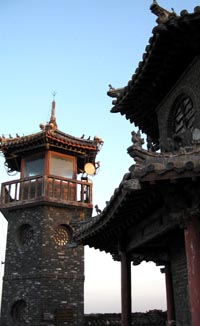| Tools: Save | Print | E-mail | Most Read |
| Liugong -- A Historical Tiny Isle |
| Adjust font size: |
From a distance, The 3.15-square-kilometer island was the birthplace of Today, the bitter outcome of that war still lingers in the minds of many Chinese. In April 1895, the Qing Imperial Government of China was forced to sign the Treaty of Shimonoseki, ceding The war compensation, equivalent to some seven years of It is sunny on the day of my visit. Hundreds of college students in navy camouflage are receiving military drills in an open space in front of old army houses just 200 meters from the ferry dock. For its historical significance, The Occupying an area of 100,000 square meters, or the size of 14 soccer fields, the museum holds dozens of important historical sites from the war, such as the Northern Fleet Commanding Office, Visitors enter the museum through the door of the Northern Fleet Commanding Office. Four golden Chinese characters "haijun gongsuo", meaning navy head office, glitter in the sunshine over the Qing-style gate. It was written by Li Hongzhang, chief minister of the Qing government who founded the Chinese Northern Fleet. Li was a controversial figure. He was also the one who represented the Qing government when signing the humiliating treaty with But Li was also the one who led Unlike Inside the head office compound are a number of brick and wood houses of Manchu-style. German Krupp cannons salvaged from the sunken warships are also on display outside these houses. Relics, wax figures, pictures, models and video programs have all combined to bring visitors back into the heart of that bloody battle. The names and ranks of some 600 Northern Fleet army were carved on the wall in the memorial hall. Northwest of the head office is Commander Ding Ruchang's residence. Ding, head of the Northern Fleet, committed suicide after seeing his fleet crushed by the Japanese. He was later scapegoated by the corrupt Qing government for the debacle. East of the residence is the site for the naval academy, which was burned down during the war. Xiyuan Men, a gate to the academy, still stands there as a reminder of the academy, with teachers from Ruins of the Iron Dock along the coast is also an impressive site. In the heyday of the Northern Fleet, 50 naval ships anchored here. After spending hours refreshing a history class in the compound, I jump on a circle-the-island tour bus. In truth, it just goes around half of the island. On this ride, you can see many old houses built by the British, which leased the island from the weak Qing government for 42 years from 1898 to 1940. The (
|
| Tools: Save | Print | E-mail | Most Read |
 |
| Related Stories |
|
|
Product Directory China Search |
Country Search Hot Buys |
